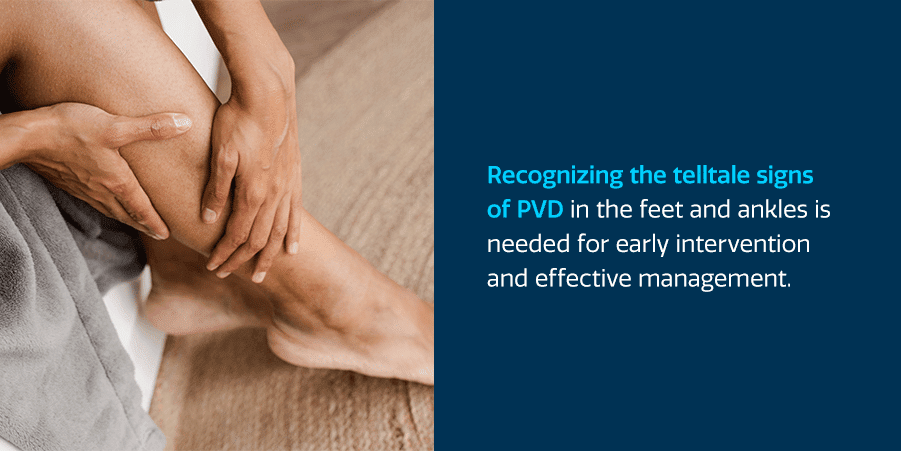The intricate network of blood vessels coursing through our bodies plays a pivotal role in maintaining health and vitality. When these pathways encounter challenges, the repercussions can be significant. Peripheral Vascular Disease (PVD) poses a particular concern when it strikes the feet and ankles.
The reduced blood flow characteristic of PVD can impact the feet and ankles, which are critical for mobility and balance. This article aims to look at the intricacies of Peripheral Vascular Disease and provide a roadmap for understanding the condition.
Understanding Peripheral Vascular Disease
PVD is a complex circulatory disorder that primarily affects the arteries outside the heart and brain, often manifesting in the lower extremities, such as the feet and ankles. It is a condition characterized by the narrowing, hardening or blockage of these peripheral arteries, resulting in reduced blood flow to the affected areas. This insufficiency of blood supply can lead to discomforting symptoms and potential complications.
The Pathogenesis and Risk Factors
The chief underlying cause of PVD is atherosclerosis, a process in which fatty deposits, cholesterol and other substances accumulate within the arterial walls, forming plaques. These plaques progressively narrow the arteries and compromise blood flow. Additionally, certain risk factors increase the susceptibility to developing PVD:
- Smoking: Smoking damages the arteries, accelerates plaque formation and significantly elevates the risk of PVD.
- Diabetes: High blood sugar levels can damage blood vessels, contributing to the development of atherosclerosis.
- Hypertension: High blood pressure strains arterial walls, making them more prone to damage and plaque formation.
- Hyperlipidemia: Elevated cholesterol levels and triglycerides contribute to plaque buildup in arteries.
- Age: As individuals grow older, the risk of PVD increases due to the cumulative effects of risk factors and the natural aging process of arteries.
- Obesity: Excess body weight strains the circulatory system and promotes atherosclerosis.
- Family History: A genetic predisposition to cardiovascular diseases can increase the likelihood of PVD.
- Inactive Lifestyle: Lack of physical activity can lead to poor circulation and exacerbate other risk factors.
Recognizing Peripheral Vascular Disease Symptoms
Recognizing the telltale signs of PVD in the feet and ankles is needed for early intervention and effective management. As the condition progresses, the symptoms can become more pronounced and impact daily activities. By understanding these indicators, individuals can seek medical attention promptly and take steps to alleviate discomfort.

- Intermittent claudication: This term refers to pain, cramping or fatigue in the leg muscles, particularly during physical activities such as walking or climbing stairs. Intermittent claudication arises due to reduced blood flow to the leg muscles, leading to inadequate oxygen supply during exertion.
- Numbness and tingling: This sensation arises from compromised nerve function due to reduced blood circulation. Numbness can impact mobility and increase the risk of injuries, as individuals may not be fully aware of their foot placement or any potential hazards.
- Skin changes: Observing changes in the skin of the feet and ankles is crucial.
- Changes in nail and toe appearance: Pay attention to changes in the appearance of nails and toes, as these can also indicate PVD. Nails may become thicker and more brittle due to decreased blood circulation. They might also turn bluish or pale due to reduced oxygen supply.
- Ulcers and non-healing wounds: Advanced stages of PVD can result in non-healing ulcers or wounds, particularly on the feet. These ulcers can be painful, prone to infection and may require medical attention.
Diagnosis and Medical Assessment
Timely identification of the condition’s severity and extent lets health care professionals devise targeted treatment strategies to improve blood flow, alleviate symptoms and enhance overall vascular health.
Ankle-Brachial Index
The Ankle-Brachial Index (ABI) is a simple and non-invasive test commonly used to diagnose PVD. It involves comparing the blood pressure at the ankle with the blood pressure in the arm. A lower ABI value indicates decreased blood flow to the lower extremities, suggesting the presence of PVD. This test is valuable in assessing the severity of the condition and tracking its progression over time.
Doppler Ultrasound
Doppler ultrasound is another widely employed diagnostic tool for PVD. This imaging technique uses sound waves to create images of blood flow in the arteries. It can detect blockages, narrowed arteries and blood clots, providing valuable insights into the state of blood circulation in the feet and ankles.
Angiography
In cases where more detailed information is required, angiography may be recommended. For an angiography test, a professional health care provider must inject a contrast dye into the bloodstream and use X-rays to visualize blood vessels. This procedure can provide precise information about the location and extent of arterial blockages or narrowing, aiding in treatment planning.
Peripheral Vascular Disease Treatment Options
Once you’ve been diagnosed with peripheral vascular disease, you can look at addressing PVD in the feet and ankles. Treatment usually requires a multifaceted approach to improve blood circulation, alleviate symptoms and prevent further complications. Treatment options range from lifestyle modifications to medical interventions tailored to the severity of the condition and the individual’s overall health:
- Lifestyle modifications: Engaging in regular physical activity under medical supervision can improve blood flow, strengthen muscles and enhance overall cardiovascular health. Walking, swimming and stationary cycling are low-impact options that can be beneficial.
- Healthy diet: Adopting a heart-healthy diet rich in fruits, vegetables, whole grains, lean proteins and healthy fats can help manage underlying risk factors such as high cholesterol and hypertension.
- Smoking cessation: Quitting smoking is essential, significantly improving blood circulation and reducing the risk of further arterial damage.
- Antiplatelet and anticoagulant medications: These medications help prevent blood clots from forming, reducing the risk of blockages in narrowed arteries.
- Cholesterol-lowering drugs: Statins and other cholesterol-lowering medications help manage high cholesterol levels, preventing further plaque buildup in arteries.
Other procedures your health care professional might suggest are:
- Angioplasty: In this minimally invasive procedure, a catheter with a balloon is threaded into the narrowed artery. The balloon is inflated to widen the artery and improve blood flow. A stent (a small mesh tube) may be placed to keep the artery open.
- Atherectomy: This procedure involves using a specialized catheter to remove or break down plaque buildup from the artery walls.
Comprehensive Care
PVD management often requires collaboration between various medical professionals:
- Vascular surgeons: Experts in treating arterial and vascular conditions, they may perform procedures like angioplasty or bypass surgery.
- Cardiologists: Heart specialists who can address overall cardiovascular health and manage risk factors.
- Podiatrists: Foot specialists who can advise on foot care, wound management and preventing ulcers.
Let Foot & Ankle Surgical Associates Help You Put Your Best Foot Forward
Navigating the complexities of PVD in the feet and ankles demands a thorough understanding of its causes, symptoms and treatment options. Foot & Ankle Surgical Associates is committed to enhancing the quality of life for our patients by providing the highest level of care and investing in the well-being of our staff. We recognize that PVD can impact daily life, from mobility to overall comfort.
We strive to deliver treatments that yield positive results by embracing medical technology advancements. Our dedicated doctors and staff will provide exceptional care tailored to your needs by supporting you every step and providing expert guidance and compassionate care that underscores our dedication to improving your quality of life. Contact us today for more information.





